 |
December 2006 – It seems unthinkable to leave this year, the 250th anniversary of his birth, without a salute to the genius of Wolfgang Amadeus Mozart.  Although barely appreciated in his own time, since his demise we've come to regard Mozart in terms of religious awe. Although barely appreciated in his own time, since his demise we've come to regard Mozart in terms of religious awe.
While the brilliance and perfection of his operas, concerti, chamber music, serenades and sonatas are widely hailed for their ideal integration of form and feeling, perhaps the most stunning distillation of his astounding genius arose in his last three symphonies, written in a miraculous blaze during the summer of 1788 (along with at least a half-dozen other works). They form an extraordinary trio – # 41 in C-Major presents a dazzling summation of Mozart's past, # 39 in E-flat Major encapsulates the art of his present, and # 40 in g-minor vaults into the future and the music of our own time. written in a miraculous blaze during the summer of 1788 (along with at least a half-dozen other works). They form an extraordinary trio – # 41 in C-Major presents a dazzling summation of Mozart's past, # 39 in E-flat Major encapsulates the art of his present, and # 40 in g-minor vaults into the future and the music of our own time.
Like Mozart's final work, the Requiem, the inspiration and genesis of his last symphonies is shrouded in mystery. Although he duly entered them in the thematic catalog in which he recorded the opening of each completed composition, Mozart never once mentions any of them in his copious correspondence, which fosters our understanding of nearly all his other major compositions. Nor have historians found any evidence of a commission (for which nearly all his other work was written to order), nor even an indication of a concert for which they might have been intended.
Scholars still can only speculate why they were written. Three principal theories have emerged. Possibly, they were intended for a series of subscription concerts in June and July 1788 that never materialized or were cancelled for insufficient interest  (as Mozart's career was then in a slump from which it would only recover posthumously). Or, Mozart may have planned to present them during a trip to England (as Haydn would do in 1791) where German composers, led by Handel, had already met with great artistic (and, for Mozart, much-needed financial) success. Or, he might have hoped to publish them as a single opus, which at the time often consisted of three complementary works in the same genre. (as Mozart's career was then in a slump from which it would only recover posthumously). Or, Mozart may have planned to present them during a trip to England (as Haydn would do in 1791) where German composers, led by Handel, had already met with great artistic (and, for Mozart, much-needed financial) success. Or, he might have hoped to publish them as a single opus, which at the time often consisted of three complementary works in the same genre.
But perhaps the most compelling explanation is held by Martin Bookspan, among others, who credits these works to an inner compulsion to create - a matter of personal expression without regard to the demands of patrons or public. That motivation, in turn, goes far to explain their extraordinary scope and striking ingenuity, which surely would have been lost on audiences of the time, and especially during only a single hearing at a typical concert. Abstract creativity also accounts for their internal unity and continuity, since symphonies at the time routinely were split in half to open and close a concert, sandwiching two hours of intervening arias, concerti and even improvisations.
Taken together, the three final symphonies seem to explore Mozart's personality. # 39 is gentle, buoyant and courtly, as if to reflect the royal patronage upon which he depended for his livelihood and from whose expectations he didn't dare stray too far. # 40 is a rare foray into gravity (one of his only two symphonies in minor keys), perhaps reflecting Mozart's depression over his waning popularity, dwindling finances, cancelled concerts,

1789 portrait of Mozart
drawn by Doris Stock |
indifferent publishers, few students, daughter' death and the numbingly dull task he faced of providing dances for royal soirees to stave off poverty. # 41 reflects the invincible spirit and optimistic aplomb that spurred him to keep creating work of brilliance and inspiration that transcended his gloomy personal circumstances and far surpassed the limited horizons of his audiences. Despite their striking diversity, all three symphonies share a common innovation by shifting emphasis from the traditionally weightiest first movements to their finales, each of which contains an astounding bravura artistic gesture.
Mozart began his career as a burgeoning symphonist. Before leaving his teens, he wrote several dozen symphonies that, while respectful of his models, consistently transcend juvenilia with superb craftsmanship and inventive touches. (The standard numbering lists only 41, but was established by a publisher in the 1870s; since then, research has uncovered twenty-five more symphonies and found that #37 was mostly by Michael Haydn, for which Mozart merely had written a 20-bar introduction.) Yet Mozart had written only one symphony in the prior five years - the vibrant 1786 "Prague", which, as with all his prior work, he wrote for a specific purpose - here, to present in the city where his operas had triumphant success.
The first of Mozart's final symphonies to emerge during that miraculous summer was # 39 in E-flat Major.
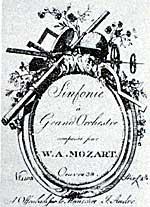
The first edition of #39 |
Nestled comfortably within its era and the most modest of the three, its high inspiration easily would have crowned the career of nearly any other contemporary. It begins with a rejection of the past and a firm assertion of insistence of contentment to dwell in the present, as the stately introduction enters in the double-dotted rhythm of a baroque French overture but then flouts the suggestion by rising to a climax as tympani lead the full orchestra to pound out a single-dotted rhythm, as if to defy any suggestion of lapsing into the old manner. The finale presents a startling personalizing of classical style. Although through Mozart's irrepressible invention we hardly notice, it's based entirely on a single theme, as if to boast that of all composers he alone would dare to - and could - succeed with such a virtuoso feat.
# 41 in C Major is known as the "Jupiter." Although the sobriquet was added only by an English publisher in the 1820s, it seems fully suitable and has adhered, aptly conjuring regal demeanor and Olympian grandeur, which indeed characterize the work,
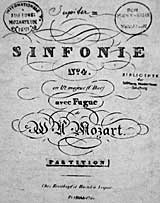
First edition of the Jupiter score - # 4, "avec Fugue" |
from its rapt and heroic opening, through its pensive andante cantabile and liquid menuetto that magically alternates phrases of driving power and mellow relaxation to fluently blend the moods of the prior two movements. Yet from the outset it was the finale that drew notice. Its first, posthumous, publication (which designated it as Mozart's fourth symphony, thus suggesting how few had been issued during his lifetime) distinguished it as being "with fugue," yet the extraordinary density and brevity of the ending hardly qualify in the established sense of that term. Even though the proliferation of counterpoint, frequent imitative figures and profusion of melodies throughout the movement provide ample hints of what is to come, it's still a surprise and delight when, after Mozart teases us by toying with an inversion of the main theme, the last minute explodes in an astounding display of polyphony.
The complexity of the coda is impossible to grasp upon a single hearing, or even just a few, yet, teasingly it's one of the few sections of the work not marked with a repeat. Not only does it display Mozart's thorough mastery of his predecessors' art, but it resonates with personal significance as closure to his symphonic career - Neal Zaslow notes that the primary theme - whole notes of C-D-F-E - was not only a well-known Gregorian chant but the theme of Mozart's very first symphony, written when he was eight!
The sheer craftsmanship of the coda and its extraordinarily tight structure are breathtaking, and all the more amazing as it sounds wholly instinctive. Leonard Ratner charts the permutation of its five themes as rotating strictly through the five string instruments every four measures, doubled by various winds, while a "rhythm section" of horns, trombones and tympani pound out the pulse. Entrances comfortably alternate on tonic and dominant, the final note of each appearance gliding smoothly into the beginning of the next only a whole tone apart, so that the interval rises and falls in a set pattern. The regularity of the scheme integrates the diverse personalities of the disparate themes that range from gently undulating whole notes to leaping intervals and syncopated rapid runs. But just as we begin to become accustomed to the design, Mozart smoothly but firmly signals its end by skipping a beat and disrupting the pattern with two successive tonic entrances, and then proceeds to an exultant and dazzling finish, as the five themes mesh and then meld into celebratory fanfares to conclude the work in a magnificent upbeat salute to the past.
Yet, despite these glories, of the three final symphonies - indeed, of all Mozart's symphonic output - the g minor (#40) is the most startling of all.

First edition of the g-minor |
Throughout the nineteenth century, its darker tone was hailed as a rare advance from the presumed superficiality of Mozart's other work. Indeed, it's an astounding balance and blending of seeming opposites: polished precision and spontaneous utterance, stringent formalism and heartfelt emotion, personal expression and universal humanism. It boasts an incomparable degree of internal unity in which every note seems integral and predestined and where even a minor cut, harmonic shift or altered inflection would threaten to devastate the exquisite world of intrinsic perfection that Mozart created. Above all, despite the many years and all the sweeping changes of style that have shaped our perception since its creation, it remains intensely affecting.
Of his final three symphonies, the 40th is the most likely to have been heard in Mozart's life, simply because it exists in two versions - originally without and then with clarinets. The latter presumably was made in anticipation of a specific performance (even if it never materialized), as Mozart often customized his work to available resources. While most recordings are of the second version, George Tintner, for one, prefers the original, "for the simple reason that the clarinets, however lovely they are, make this work a little more amiable, a little less uncompromising and desperate, as I think it should be."
The influence of the 40th is vast and begins with its very first moment.

The opening of Mozart's Symphony # 40 in g-minor |
The unprecedented opening bar of bare quivering harmony before the melody emerges inspired everyone from Haydn (the famed inchoate opening of his "Creation" oratorio) through Beethoven (the atmospheric suspense that begins his Ninth Symphony) to much, if not most, of Bruckner and Mahler. Its astoundingly meticulous orchestration, announced at the outset by using only strings, set a new standard for expressing mood and atmosphere through instrumental resources. (When Liszt boasted of his prowess for transcribing anything for the piano, Mendelssohn reportedly challenged him to play the opening of the Mozart 40th.) Its pervasive melancholy and profound personal feeling elevated the symphony from its function as a trifling concert overture to the most introspective and weighty of all musical statements and paved the way for much of the work of the 19th century.
The overall mood is hard to summarize, although many have tried, citing resignation, despair, tragedy, dejection and sorrow. In any event, the facets of this overall aura of profundity are explored through all four movements that, in Alfred Heuss's analysis, are permeated and unified by the grief-tinged interval of a diminished second. The first is brooding yet propulsive, constantly striving to surpass a foundation of world-weary, gentle despair to which it remains anchored.

The first staff of the autograph of the Symphony # 40 minuet.
Note the corrections, which rebut the Amadeus myth that Mozart scores were letter-perfect. |
The second, although in a major key, is heartbreakingly tentative and wistful and thus ultimately extends rather than relieves the overall doleful mood. The menuetto's bass-heavy instrumentation, 3-bar phrasing, syncopated clumsiness and overall ominous grim resolve all serve to drain it of any vestige of the grace, vigor and joyous relief such dance-like movements typically offer. The principal theme of the tumultuous finale consists of a rising phrase followed by a gruff earth-bound one, as if to suggest constant effort followed by defeat, or perhaps a series of perpetual, insistent, open-ended questions, followed by perfunctory and wholly unsatisfactory answers, an efficient yet grim portrait of the human condition.
Yet, as if all this were not enough, there remains one of the most extraordinarily prescient gestures in all of music. At the beginning of the development section of the finale, Mozart disrupts his rising theme with a sour note and a semi-tone, and then launches into a sequence of ten tones of the chromatic scale (notably omitting g-natural, the tonic), all played in unison so as to avoid any distraction through even a hint of counterpoint or conventional harmonization.

The disrupted melody and tone row of the finale of the Symphony # 40. |
At the same time, the previously steady 4/4 rhythm disintegrates into irregular syncopation. But this is not mere random scrambling - ignoring the three triplet pick-up notes, it's structured with rigorous mathematical logic as an interlocking series of diminished fourths and diminished sevenths, the least tonally anchored of all intervals. As Heinrich Jalowetz noted, "For a fleeting moment the sequence escapes from the gravity of diatonic (tonal) space and sets up a genuine chromatic (atonal) segment." Since each note takes its turn and holds its own before any is repeated or emphasized, Mozart formed nothing less than a tone row of the very type that would be "discovered" by Arnold Schoenberg in the 1920s and that would transform and liberate the 20th century from the exhausted tonal system that had served Western music for 400 years!
Perhaps the ultimate wonder of this visionary flight is not its technical detail but its emotional effect. Without a score in hand, few listeners would ever suspect that such an exceptional event had even taken place, yet it subtly transforms the piece. The remaining half of the movement seems ever so slightly brighter and its burdens lighter, as Mozart's glance into the future adds just a glimmer of hope, as if to say that although life itself is basically sorrowful, steadfast dignity and faith in the future hold a crucial promise of uplift and redemption.
Not content to merely point the way to much of the 19th century, Mozart leapt ahead five generations to enter the 20th. Not satisfied to sit astride his own world, Mozart escaped it altogether. Not only the complete master of the styles of the past and his own era, with this one astounding and visionary gesture Mozart proved himself a prophet whose talent knew no bounds or constraint.
H.C. Robbins Landon reports that, upon learning of Mozart's untimely death, Haydn remarked that the world would not see such a talent again in a hundred years, but he was wrong. It's now been a quarter-millennium since Mozart's birth. We're still waiting.
While many musicians knew better,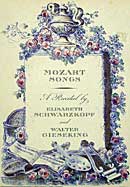 it's hard to imagine that until well into the 20th century Mozart's music generally was dismissed as trite and effete; indeed, many early Mozart books and record albums were decorated with ostensibly appropriate pastel floral patterns. The major exceptions to this popular delusion were his late operas and symphonies, of which recordings first emerged in 1913. Of the many dozens now available, it's hard to go far wrong, so rich and so gratifying is this material. it's hard to imagine that until well into the 20th century Mozart's music generally was dismissed as trite and effete; indeed, many early Mozart books and record albums were decorated with ostensibly appropriate pastel floral patterns. The major exceptions to this popular delusion were his late operas and symphonies, of which recordings first emerged in 1913. Of the many dozens now available, it's hard to go far wrong, so rich and so gratifying is this material.
The performance of Mozart symphonies spawns many issues. The fundamental concern is how closely (or even whether) to attempt to emulate the experience of a late 18th century audience. Of course, the pretense of hearing Mozart's work as ingeniously new nowadays is simply impossible in light of the enormous aesthetic changes since then. Yet, each performer must confront basic questions of approach. Should we take full advantage of the enhanced resources of modern orchestras or should forces be reduced to reflect the ensembles for which Mozart wrote? Should conductors assert their own personalities to add interest to works we take for granted, or simply keep a steady tempo as Mozart reportedly did? Should the program include works of more recent eras, or only of Mozart's time?
Perhaps the most vexing question is repeats, which, far more than whirlwind or plodding tempos, accounts for the vastly different timings to be encountered among recordings of the late Mozart symphonies. (Thus, Celibidache's leisurely-paced g-minor runs only 24 minutes while Harnoncourt's far brisker reading - with all repeats - weighs in at 36.)   Mozart indicated repeats of most sections of his symphonies, not as a means of padding out concerts, but rather to serve a more practical purpose. While a few gifted listeners may have grasped or even memorized a new symphony in a single hearing, encores and performances of past repertoire were rare, scores (when issued) had limited circulation, and the vast majority of listeners were unlikely to ever hear a work again. Thus, repeats enabled audiences to better absorb a new piece and savor its innovations. Nowadays, the need for repeats is largely obviated by technology, which enables us to replay a passage, a movement or even an entire work whenever and as often as we wish. Repeats also tend to create an aura of monumentality that seems at odds with Mozart's ethos and conflict with our impatient modern pace of barely pausing before moving on to the next attraction. Thus the modern quandary: is Mozart's intent entitled to deference, especially if we are to try to hear his works as he had anticipated, or should we account for contemporary reality and assume that Mozart would have dispensed with repeats (and exploited the power of large, modern orchestras) were he living nowadays? (But, of course, if Mozart were among us, he surely wouldn't have composed in the now-quaint classical style.) Mozart indicated repeats of most sections of his symphonies, not as a means of padding out concerts, but rather to serve a more practical purpose. While a few gifted listeners may have grasped or even memorized a new symphony in a single hearing, encores and performances of past repertoire were rare, scores (when issued) had limited circulation, and the vast majority of listeners were unlikely to ever hear a work again. Thus, repeats enabled audiences to better absorb a new piece and savor its innovations. Nowadays, the need for repeats is largely obviated by technology, which enables us to replay a passage, a movement or even an entire work whenever and as often as we wish. Repeats also tend to create an aura of monumentality that seems at odds with Mozart's ethos and conflict with our impatient modern pace of barely pausing before moving on to the next attraction. Thus the modern quandary: is Mozart's intent entitled to deference, especially if we are to try to hear his works as he had anticipated, or should we account for contemporary reality and assume that Mozart would have dispensed with repeats (and exploited the power of large, modern orchestras) were he living nowadays? (But, of course, if Mozart were among us, he surely wouldn't have composed in the now-quaint classical style.)
The vast majority of the large number of available recordings of the final symphonies, despite their variety, manage to stand out as inventive yet idiomatic. At the risk of oversimplification, I've tried to group my favorites according to their fundamental approach. Each heading gives the symphonies recorded, the orchestra, the year and current CD availability:
- THE MODERNISTS – Out of a sense of respect for Mozart's genius, and in reaction to the late 19th century approach of asserting strongly individualized performer personalities, these conductors generally avoid overt interpretive touches:
- Richard Strauss
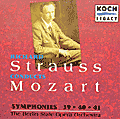 (all of the last 3 symphonies - Berlin State Opera Orchestra, 1926-7, Koch CD) - While his fame as a conductor has now been fully eclipsed by his compositions, Strauss was in the forefront of modernism, known for fast tempos, clipped phrasing and a nearly complete absence of the rhetorical interpretive touches routinely added by his contemporaries. I've grouped him here strictly on the basis of his reputation, which his Mozart symphony records often belie. While his 20-minute g-minor is relatively chaste, the others display huge tempo swings that seem schematic, as they mostly parallel the dynamic design of the music - slow for soft or anticipatory passages, fast for loud or climactic ones. While the generally swift pace adds tangible excitement, their expressiveness effectively rebuts critics who damn Strauss for fierce and unfeeling records. An added bonus - all three take a mere 66 minutes, while most others' can't fit on a single CD. (all of the last 3 symphonies - Berlin State Opera Orchestra, 1926-7, Koch CD) - While his fame as a conductor has now been fully eclipsed by his compositions, Strauss was in the forefront of modernism, known for fast tempos, clipped phrasing and a nearly complete absence of the rhetorical interpretive touches routinely added by his contemporaries. I've grouped him here strictly on the basis of his reputation, which his Mozart symphony records often belie. While his 20-minute g-minor is relatively chaste, the others display huge tempo swings that seem schematic, as they mostly parallel the dynamic design of the music - slow for soft or anticipatory passages, fast for loud or climactic ones. While the generally swift pace adds tangible excitement, their expressiveness effectively rebuts critics who damn Strauss for fierce and unfeeling records. An added bonus - all three take a mere 66 minutes, while most others' can't fit on a single CD.
- Arturo Toscanini
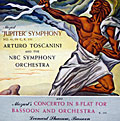 (all 3 - NBC Symphony, 1939-53, BMG) - The most famed of the modern "objective" conductors, Toscanini's Mozart studio readings with his NBC Symphony compensate for their utter lack of charm with slashing visceral excitement. Interestingly, an earlier 1929 recording of the Symphony # 35 with the New York Philharmonic is far more yielding, with considerable warmth and tempo variation, when compared to his 1946 NBC recording of that work, thus suggesting a wider range to his art than his NBC studio output reveals. Similarly, a 1949 NBC concert of the Jupiter notably slows for each iteration of the first movement's main theme and achieves incisive urgency by emphasizing not only each downbeat but the internal rhythms through prominent tympani accents and overall instrumental inflection. (all 3 - NBC Symphony, 1939-53, BMG) - The most famed of the modern "objective" conductors, Toscanini's Mozart studio readings with his NBC Symphony compensate for their utter lack of charm with slashing visceral excitement. Interestingly, an earlier 1929 recording of the Symphony # 35 with the New York Philharmonic is far more yielding, with considerable warmth and tempo variation, when compared to his 1946 NBC recording of that work, thus suggesting a wider range to his art than his NBC studio output reveals. Similarly, a 1949 NBC concert of the Jupiter notably slows for each iteration of the first movement's main theme and achieves incisive urgency by emphasizing not only each downbeat but the internal rhythms through prominent tympani accents and overall instrumental inflection.
- Felix Weingartner (# 39 - London Philharmonic, 1940, EMI) - Weingartner, too, was in the forefront of modern conductors, with this moderate, steady reading that seems the first without any personal intrusion of any kind, thus treating Mozart with utter dignity and devotion so as to present his music unadorned.
- Ernest Ansermet (#s 40 & 41 - Orchestre de la Suisse Romande, 1942, Lys)
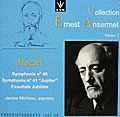 - Although renowned as a French specialist and encouraged to record that repertoire, Ansermet's oft-professed love of Mozart is abundantly clear. Trained as a mathematician, Ansermet strove for clarity and balance, an ideal approach to Mozart. Further benefiting from Ansermet's extensive experience as a ballet conductor, both symphonies (recorded in a single day) emerge with remarkable grace and elegance unmatched in any other recordings, yet without diminishing their essential dignity. - Although renowned as a French specialist and encouraged to record that repertoire, Ansermet's oft-professed love of Mozart is abundantly clear. Trained as a mathematician, Ansermet strove for clarity and balance, an ideal approach to Mozart. Further benefiting from Ansermet's extensive experience as a ballet conductor, both symphonies (recorded in a single day) emerge with remarkable grace and elegance unmatched in any other recordings, yet without diminishing their essential dignity.
- Fritz Reiner (# 40 - Pittsburgh Symphony, 1946, Sony; also all 3 - Chicago Symphony, 1957, RCA LP) - Reiner is strict but not severe, exercising extraordinary care and control;
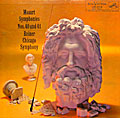 his only personal indulgence is a slight retard at the end of each structural segment. his only personal indulgence is a slight retard at the end of each structural segment.
- Erich Kleiber (# 40 - London Philharmonic, 1949, London) - In a fine demonstration of Decca's Full Frequency Range Recording technique, the sharp and silky hi-fi sonic quality in and of itself revealed a degree of delicate elegance utterly absent from all other cruder recordings up to that point. While the performance is so light as to seem shallow, the sheer detail of the sound opens up a realm of interpretive possibilities based on subtlety rather than pointed emphasis.
- Hermann Scherchen (#s 40 and 41 - Champs-Elysees Theatre Orchestra, 1953, Tahra)
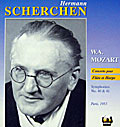 - Scherchen sought transparency as his Mozart interpretive ideal, and he achieved it here by projecting delicacy and elegance with a chamber-sized ensemble. - Scherchen sought transparency as his Mozart interpretive ideal, and he achieved it here by projecting delicacy and elegance with a chamber-sized ensemble.
- George Szell (all 3 - Cleveland Orchestra, 1960-4, Sony CD) - Szell honed his orchestra to a fine degree of mechanical accuracy that works especially well with Haydn and Mozart, where his meticulous care highlights the purity of their textures, abetted by crystalline early stereo recording. Yet, to avoid mechanical boredom, his readings temper his judicious pacing and sharp precision with surprising warmth.
- Otto Klemperer (all - Philharmonia, 1956-62, EMI)
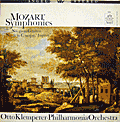 - Klemperer's unrelieved sobriety and dignity may strike some as joyless, drained of spirit and utterly boring, and others as reflecting unparalleled honesty, integrity and self-effacement. But even his detractors must admit that he manages to lace his Mozart recordings with rhythmic lilt and light textures. He also pioneered a return in modern times to the former routine practice of separating first and second violins to stage left and right, so as to add a spacial dimension to their interplay. A 1970 Philharmonia concert of the g-minor (Arcadia) is four minutes slower than in the studio and, depending on your view, all the more dismal and labored or worldly and intense. - Klemperer's unrelieved sobriety and dignity may strike some as joyless, drained of spirit and utterly boring, and others as reflecting unparalleled honesty, integrity and self-effacement. But even his detractors must admit that he manages to lace his Mozart recordings with rhythmic lilt and light textures. He also pioneered a return in modern times to the former routine practice of separating first and second violins to stage left and right, so as to add a spacial dimension to their interplay. A 1970 Philharmonia concert of the g-minor (Arcadia) is four minutes slower than in the studio and, depending on your view, all the more dismal and labored or worldly and intense.
- Wilhelm Furtwangler
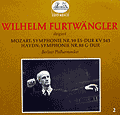 (# 39 - Berlin Philharmonic, 1944, DG; # 40 - Vienna Philharmonic, 1949, EMI) - It's rare to include Furtwangler in a list of "objective" performances, but his g-minor, while beautifully conceived and played, completely avoids his usual hallmark of internalized subjectivity, as does an only slightly more inflected 1949 Berlin Philharmonic concert at Weisbaden (Music & Arts). Indeed, the sheer speed of the outer movements makes it one of the fastest of all recordings of the work. His 1944 Berlin concert of # 39, though, is more typical - despite heavy overload distortion, it's nimbly fashioned and pulses with vitality and nuance. (# 39 - Berlin Philharmonic, 1944, DG; # 40 - Vienna Philharmonic, 1949, EMI) - It's rare to include Furtwangler in a list of "objective" performances, but his g-minor, while beautifully conceived and played, completely avoids his usual hallmark of internalized subjectivity, as does an only slightly more inflected 1949 Berlin Philharmonic concert at Weisbaden (Music & Arts). Indeed, the sheer speed of the outer movements makes it one of the fastest of all recordings of the work. His 1944 Berlin concert of # 39, though, is more typical - despite heavy overload distortion, it's nimbly fashioned and pulses with vitality and nuance.
- George Tintner
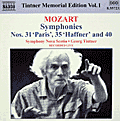 (#s 40 & 41 - Symphony Nova Scotia, 1994 and 1988, Naxos) - An inheritor of the mantle of humility, Tintner's Mozart is fully stylish without any hint of extrinsic personality, cleanly accented without any self-consciousness. With all repeats they approach 37 and 40 minutes, yet seem all too brief, so fully does Tintner succeed in focusing our attention on the sublime music. Throughout his long and varied career, Tintner sought out conducting assignments in unlikely places to apply his compulsion to educate both performers and audiences; here, the impeccable playing of these works by a 37-member provincial ensemble exemplifies and justifies his loving, humanistic care. (#s 40 & 41 - Symphony Nova Scotia, 1994 and 1988, Naxos) - An inheritor of the mantle of humility, Tintner's Mozart is fully stylish without any hint of extrinsic personality, cleanly accented without any self-consciousness. With all repeats they approach 37 and 40 minutes, yet seem all too brief, so fully does Tintner succeed in focusing our attention on the sublime music. Throughout his long and varied career, Tintner sought out conducting assignments in unlikely places to apply his compulsion to educate both performers and audiences; here, the impeccable playing of these works by a 37-member provincial ensemble exemplifies and justifies his loving, humanistic care.
- Erich Leinsdorf (# 41 - Boston Symphony, 1964, RCA LP)
 - The Boston Symphony billed itself as the “Aristocrat of Orchestras,” yet its Jupiter, while indeed quite noble, has none of the indifference or lethargy that such a label might suggest. Rather, Leinsdorf achieves a fine balance of weightiness and propulsion in which the sonority of the modern orchestra, with a rich, luxuriant, smooth sonority heavily favoring the strings, is offset by sharp detail, lovely balances and buoyant execution throughout its nearly 40 minutes. The andante is especially poignant and emotionally involving, perhaps because its presentation speaks in an idiom with which we are familiar. (And to show that the design is intentional, the LP companion was a considerably lighter Eine Kleine Nachtmusik.) Despite the horrendously inappropriate rococo cover art, Leinsdorf and his Boston forces clearly view the Jupiter as a herald of the weighty symphonic statements of the next generation and implicitly raise the fascinating question of what Mozart, on the verge of rounding the corner to the next century, might have achieved had he lived to a more natural age and what his impact might have been on the course of Western music as we now know it. - The Boston Symphony billed itself as the “Aristocrat of Orchestras,” yet its Jupiter, while indeed quite noble, has none of the indifference or lethargy that such a label might suggest. Rather, Leinsdorf achieves a fine balance of weightiness and propulsion in which the sonority of the modern orchestra, with a rich, luxuriant, smooth sonority heavily favoring the strings, is offset by sharp detail, lovely balances and buoyant execution throughout its nearly 40 minutes. The andante is especially poignant and emotionally involving, perhaps because its presentation speaks in an idiom with which we are familiar. (And to show that the design is intentional, the LP companion was a considerably lighter Eine Kleine Nachtmusik.) Despite the horrendously inappropriate rococo cover art, Leinsdorf and his Boston forces clearly view the Jupiter as a herald of the weighty symphonic statements of the next generation and implicitly raise the fascinating question of what Mozart, on the verge of rounding the corner to the next century, might have achieved had he lived to a more natural age and what his impact might have been on the course of Western music as we now know it.
- Karl Bohm (all - Berlin Philharmonic, 1961-6, DG)
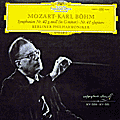 - This, too, is solid, sturdy "big band" Mozart without a hint of period style or personality. While that may sound disparaging, on the contrary it's fully respectful of the composer, beautifully played without any elements to distract us from the glorious music. - This, too, is solid, sturdy "big band" Mozart without a hint of period style or personality. While that may sound disparaging, on the contrary it's fully respectful of the composer, beautifully played without any elements to distract us from the glorious music.
- THE PRO-ACTIVE CONDUCTORS – While generally respectful of Mozart's outlook, these conductors tend to shape the music to their own artistic inclinations, using a variety of interpretive techniques, especially in the outer movements:
- Albert Coates (# 41 - London Symphony, 1927, GSE)
 - This is the most extreme, yet fascinating, Mozart symphony on record, with breakneck tempos and thundering tympani that forever shatters the image of Mozart as a delicate "Dresden doll." If shorn of repeats, it would gallop by in a mere 22 minutes, by far the fastest of all recorded Jupiters. - This is the most extreme, yet fascinating, Mozart symphony on record, with breakneck tempos and thundering tympani that forever shatters the image of Mozart as a delicate "Dresden doll." If shorn of repeats, it would gallop by in a mere 22 minutes, by far the fastest of all recorded Jupiters.
- Frederick Stock (# 40 - Chicago Symphony, 1926, Lys) - Stock differentiates structural sections through dramatic tempo shifts at transition points. As with Coates and most of the other activists, though, his creative input is limited to the outer movements, leaving the others chaste by comparison.
- Serge Koussevitzky (# 39 - Boston Symphony, 1943, Lys; # 40 - London Symphony, 1934, Biddulph)
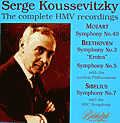 - Koussevitzky approached conducting as a sacred rite, yet not in the sense of aloof respect; rather, he never hesitated to apply his vast personality to the service of the music he led. His Mozart, while fundamentally chaste, is enlivened by interpretive touches. His # 39 is a briskly-paced concert and relatively straightforward (but with an unusually emphatic adagio), and Koussevitzky adds considerable excitement to # 40 through accelerating tempos within sections and outsized volume changes. - Koussevitzky approached conducting as a sacred rite, yet not in the sense of aloof respect; rather, he never hesitated to apply his vast personality to the service of the music he led. His Mozart, while fundamentally chaste, is enlivened by interpretive touches. His # 39 is a briskly-paced concert and relatively straightforward (but with an unusually emphatic adagio), and Koussevitzky adds considerable excitement to # 40 through accelerating tempos within sections and outsized volume changes.
- Hans Knappertsbusch (# 39 - Berlin Philharmonic, 1929 (studio); #s 40 and 41 - Vienna Philharmonic, 1941 (concerts), Music and Arts) - Known for his relaxed sense of architecture,
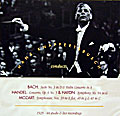 Kna's readings have just enough emphasis, tonal shading and tempo differentiation between sections to invigorate the music, while imparting to each its essential character. # 39 is fleet and light, # 40 thick and weighty (with added heft at the beginning of the finale recapitulation, followed by a tentative recovery of the melody), and # 41 rapt and exciting, but with hints of German mysticism, as if standing on the brink of the coming Romantic era. Kna's readings have just enough emphasis, tonal shading and tempo differentiation between sections to invigorate the music, while imparting to each its essential character. # 39 is fleet and light, # 40 thick and weighty (with added heft at the beginning of the finale recapitulation, followed by a tentative recovery of the melody), and # 41 rapt and exciting, but with hints of German mysticism, as if standing on the brink of the coming Romantic era.
- Pablo Casals (all - Marlboro Festival, 1967-8, Sony)
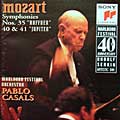 - From Bach to the romantics, whether playing his cello or conducting one of his many orchestras, Casals approached all his music with a palpable sense of purpose. These deeply masculine readings combine deliberate pacing with seething, virile muscular power to underline the depth of Mozart's feeling, which Casals clearly shared. The g-minor in particular resonates deeply within Casals's soul, and emerges as his own profoundly personal expression, propelled by inspired playing. Incidentally, don't be fooled by the nondescript name of the ensemble - the Marlboro Festival wasn't a batch of amateurs, but was assembled of first-chair players from America's top orchestras. - From Bach to the romantics, whether playing his cello or conducting one of his many orchestras, Casals approached all his music with a palpable sense of purpose. These deeply masculine readings combine deliberate pacing with seething, virile muscular power to underline the depth of Mozart's feeling, which Casals clearly shared. The g-minor in particular resonates deeply within Casals's soul, and emerges as his own profoundly personal expression, propelled by inspired playing. Incidentally, don't be fooled by the nondescript name of the ensemble - the Marlboro Festival wasn't a batch of amateurs, but was assembled of first-chair players from America's top orchestras.
- Leonard Bernstein.
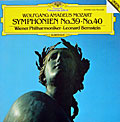 (all - Vienna Philharmonic, 1984-5, DG) - Bernstein delivers deeply heartfelt, beautifully balanced readings in which most repeats and a full modern orchestra impart monumentality and weight without sluggishness. Similary conceived, but not as fully realized, are 1961-68 New York Philharmonic readings of all three symphonies on Sony. (all - Vienna Philharmonic, 1984-5, DG) - Bernstein delivers deeply heartfelt, beautifully balanced readings in which most repeats and a full modern orchestra impart monumentality and weight without sluggishness. Similary conceived, but not as fully realized, are 1961-68 New York Philharmonic readings of all three symphonies on Sony.
- THE HISTORIANS – The common aim here is to replicate a performance of Mozart's era, using the instruments, techniques, tempos, tuning and utter lack of overt "interpretation" of the time. Ensembles are relatively small (about 40 players, although Hogwood opts for 62), all repeats are taken, textures are consistently light, pacing is moderate to swift, phrasing is crisp, and the textures can seem rugged and even coarse by modern standards.
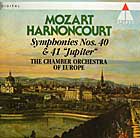 Yet, while a fair dose of speculation is involved, and while the various recordings display significant differences, the results may approach how Mozart expected his work to sound (and, of course, he composed with that sound in mind). Three of the earliest are: Yet, while a fair dose of speculation is involved, and while the various recordings display significant differences, the results may approach how Mozart expected his work to sound (and, of course, he composed with that sound in mind). Three of the earliest are:
- Christopher Hogwood (all - the Academy of Ancient Music, 1981-3, Oiseau-lyre)
- Roy Goodman (all - the Hanover Band, 1989, Nimbus)
- Roger Norrington (all - the London Classical Players, 1990-1, EMI)
- Nikolas Harnoncourt (all - Chamber Orchestra of Europe, 1991, Teldec) - Harnoncourt takes a middle ground by applying historically-informed performance practices to a modern, although modestly sized, orchestra for a slower pace and more blended sound.
- THE IMMORTALS – Two conductors have special enduring credibility in this repertoire; their work is entitled to respect not only because they championed Mozart long before his current surge of popularity, but for its intrinsic excellence that spans the generations.
- Sir Thomas Beecham (all - London Philharmonic, 1934-40, EMI)
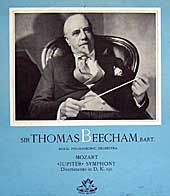 - Beecham sits in the pantheon of Mozart advocates, having proselytized for his mature symphonies in an era when this was a lonely calling and being the first to record them all (not just the last three, but six others as well). Beecham was imperious, but his spry playfulness, attentive phrasing, subtle dynamic variation, light textures and occasional gentle emphases communicate his obvious enthusiasm and affection and still commands attention. LP remakes and a stereo Jupiter are good, but the London Philharmonic 78s best capture Beecham's appeal. - Beecham sits in the pantheon of Mozart advocates, having proselytized for his mature symphonies in an era when this was a lonely calling and being the first to record them all (not just the last three, but six others as well). Beecham was imperious, but his spry playfulness, attentive phrasing, subtle dynamic variation, light textures and occasional gentle emphases communicate his obvious enthusiasm and affection and still commands attention. LP remakes and a stereo Jupiter are good, but the London Philharmonic 78s best capture Beecham's appeal.
- Bruno Walter
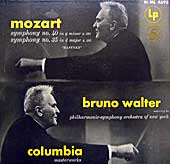 (all - 1930s, Vienna and Berlin Philharmonics, Lys; New York Philharmonic, 1953-6, Sony; and Columbia Symphony, 1958, Sony) - Walter was the other famed Mozartean of his time. His mono NY Philharmonic LP series (all 3 now on a single mid-priced CD) is a fine transition between his earlier European vigor and the autumnal glow of his stereo remakes (in a budget Odyssey CD set). While all three sets are fine in their own way, the last is truly special, as Mozart's spirit seems to guide the transcendentally sensitive playing, its emotions fully internalized and exquisitely balanced with equal shares of grace and wisdom. (all - 1930s, Vienna and Berlin Philharmonics, Lys; New York Philharmonic, 1953-6, Sony; and Columbia Symphony, 1958, Sony) - Walter was the other famed Mozartean of his time. His mono NY Philharmonic LP series (all 3 now on a single mid-priced CD) is a fine transition between his earlier European vigor and the autumnal glow of his stereo remakes (in a budget Odyssey CD set). While all three sets are fine in their own way, the last is truly special, as Mozart's spirit seems to guide the transcendentally sensitive playing, its emotions fully internalized and exquisitely balanced with equal shares of grace and wisdom.
The true proof of Mozart's eternal genius lies not in history, biography or musicology, but rather in one indisputable fact - his final symphonies (and much of his other work) not only survive but thrive across a huge realm of diverse interpretive approaches and continue to strike chords deep within listeners of an era far removed from Mozart's own.

Copyright 2006 by Peter Gutmann
|
